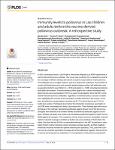Immunity levels to poliovirus in Lao children and adults before the vaccine-derived poliovirus outbreak: A retrospective study
Pauly, Maude
Black, Antony P.
Khampanisong, Phonepaseuth
Nouanthong, Phonethipsavanh
Hübschen, Judith M.
Nanthavong, Naphavanh
Sayasinh, Kong
Jutavijittum, Prapan
Samountry, Bounthome
Xeuatvongsa, Anonh
Diedrich, Sabine
Muller, Claude P.
In 2015, several provinces in Lao People's Democratic Republic (Lao PDR) experienced a vaccine-derived poliovirus outbreak. This survey was conducted (i) to evaluate the vaccination coverage in different settings and cohorts using the seroprevalence of anti-poliovirus (PV) antibodies as a surrogate measure, and (ii) to explore the usefulness of an ELISA in a country with limited resources and a specific epidemiological setting. IgG antibodies were assessed by ELISA in Lao children (n = 1216) and adults (n = 1228), including blood donors and health care workers. Protective antibody titers against the 3 vaccine serotypes were determined by microneutralization (VNT) in a subset of participants. More than 92% of the children had anti-poliovirus antibodies, regardless of nutritional status or access to health care, highlighting the success of the vaccination outreach activities in the country. In contrast, anti-poliovirus seroprevalence reached only 81.7% in blood donors and 71.9% in health care workers. Participants born before the introduction of poliovirus vaccination in Lao PDR were considerably less likely to be seropositive. These findings align with the epidemiology of the outbreak. Neutralizing antibodies against at least one of the 3 poliovirus serotypes were detected in all children (99/99) and 93/99 had antibodies against all serotypes. Similarly, all health care workers had neutralizing antibodies against at least one and 92/99 against all serotypes. The comparison of both assays shows an acceptable underestimation of vaccine coverage in children by ELISA, but a low sensitivity of the ELISA in the adults. We show that the ELISA is a reasonable alternative to the VNT in particular in vaccinated children, that an improved version should be serotype specific, and that negativity thresholds should be revisited for optimal sensitivity and specificity. Thus, polio-free countries with an uncertain vaccination coverage and limited laboratory capacity, that are at risk of vaccine-derived poliovirus outbreaks or of re-importation of wild poliovirus may benefit from an improved ELISA for cohort studies to evaluate their immunization program in children.
Dateien zu dieser Publikation

